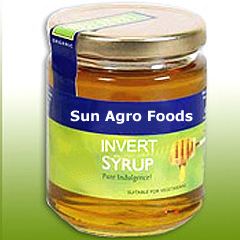Formula C12H24O12 | Molar mass 360.312 g/mol | |
 | ||
Dr lauth s lab 6 how to make sweet golden syrup inverted sugar syrup
Inverted or invert sugar syrup is a mixture of glucose and fructose; it is obtained by splitting the disaccharide sucrose into these two components. Compared with its precursor, sucrose, inverted sugar is alluringly sweet and its products tend to retain moisture and are less prone to crystallization. Inverted sugar is therefore valued by bakers, who refer to the syrup as invert syrup.
Contents
- Dr lauth s lab 6 how to make sweet golden syrup inverted sugar syrup
- Inverted sugar syrup
- Chemical reaction of the inversion
- Inverting sugar
- Shelf life
- Notable uses
- References
Sucrose is a disaccharide, a molecule derived from two simple sugars (monosaccharides). In sucrose, the monosaccharide building blocks are fructose and glucose. The splitting of sucrose is a hydrolysis reaction. The hydrolysis can be induced simply by heating an aqueous solution of sucrose, but more commonly, catalysts are added to accelerate the conversion. The biological catalysts that are added are called sucrases (in animals) and invertases (in plants). Sucrases and invertases are types of glycoside hydrolase enzymes. Acid, such as lemon juice or cream of tartar, can also accelerate the conversion of sucrose to invert sugar.
Inverted sugar syrup
Chemical reaction of the inversion
The term "inverted" is derived from the practice of measuring the concentration of sugar syrup using a polarimeter. Plane polarized light, when passed through a sample of pure sucrose solution, is rotated to the right (optical rotation). As the solution is converted to a mixture of sucrose, fructose and glucose, the amount of rotation is reduced until (in a fully converted solution) the direction of rotation has changed (inverted) from right to left.
C12H22O11 (sucrose, Specific rotation = +66.5°) + H2O (water, no rotation) → C6H12O6 (glucose, Specific rotation = +52.7°) + C6H12O6 (fructose, Specific rotation = −92°) net: +66.5° converts to −19.65° (half of the sum of the specific rotation of fructose and glucose)Hydrolysis is a chemical reaction in which a molecule breaks down by the addition of water. Hydrolysis of sucrose yields glucose and fructose about 85%; the reaction temperature can be maintained at 50–60 °C (122–140 °F).
Inverting sugar
Inverted sugar syrup can be easily made by adding water and roughly one gram of citric acid per kilogram of sugar. (Lemon juice is 5% to 6% citric acid, with a negligible amount of ascorbic acid, so this would correspond to about 20 grams of lemon juice per kilogram of sugar.) Cream of tartar (one gram per kilogram) or fresh lemon juice (10 milliliters per kilogram) may also be used.
The mixture is boiled to get to a temperature of 114 °C (237 °F), and will convert enough of the sucrose to effectively prevent crystallization, without giving a noticeably sour taste. Invert sugar syrup may also be produced without the use of acids or enzymes by thermal means alone: two parts granulated sucrose and one part water simmered for five to seven minutes will convert a modest portion to invert sugar.
Commercially prepared enzyme-catalyzed solutions are inverted at 60 °C (140 °F). The optimum pH for inversion is 5.0. Invertase is added at a rate of about 0.15% of the syrup's weight, and inversion time will be about 8 hours. When completed the syrup temperature is raised to inactivate the invertase, but the syrup is concentrated in a vacuum evaporator to preserve color.
Commercially prepared hydrochloric-acid catalysed solutions may be inverted at the relatively low temperature of 50 °C (122 °F). The optimum pH for acid-catalysed inversion is 2.15. As the inversion temperature is increased, the inversion time decreases. They are neutralized when the desired level of inversion is reached.
In confectionery and candy making, cream of tartar is commonly used as the acidulant, with typical amounts in the range of 0.15-0.25% of the sugar's weight. The use of cream of tartar imparts a honey-like flavor to the syrup. After the inversion is completed, it may be neutralized with baking soda using a weight of 45% of the cream of tartar's weight.
When adding baking soda and whipping or mixing, the hot syrup will foam and bubble up, so some care is required. A much taller pan than otherwise needed will contain the foam. Make sure there is enough water remaining in the syrup to dissolve the baking soda. Alternatively, dissolve the baking soda in a little extra water, and ensure the syrup's temperature is somewhat below 100 °C (212 °F).
The amount of water can be increased to increase the time it takes to reach the desired final temperature, and increasing the time increases the amount of inversion that occurs. In general, higher final temperatures result in thicker syrups, and lower final temperatures, in thinner ones.
All constituent sugars (sucrose, glucose and fructose) support fermentation, so invert sugar solutions may be fermented as readily as sucrose solutions.
Shelf life
Invert sugar provides more powerful preserving qualities (a longer shelf life) to products that use it.
The shelf life of partial inverts is approximately six months, depending on storage and climatic conditions. Crystallized invert sugar solutions may be restored to their liquid state by gently heating.
